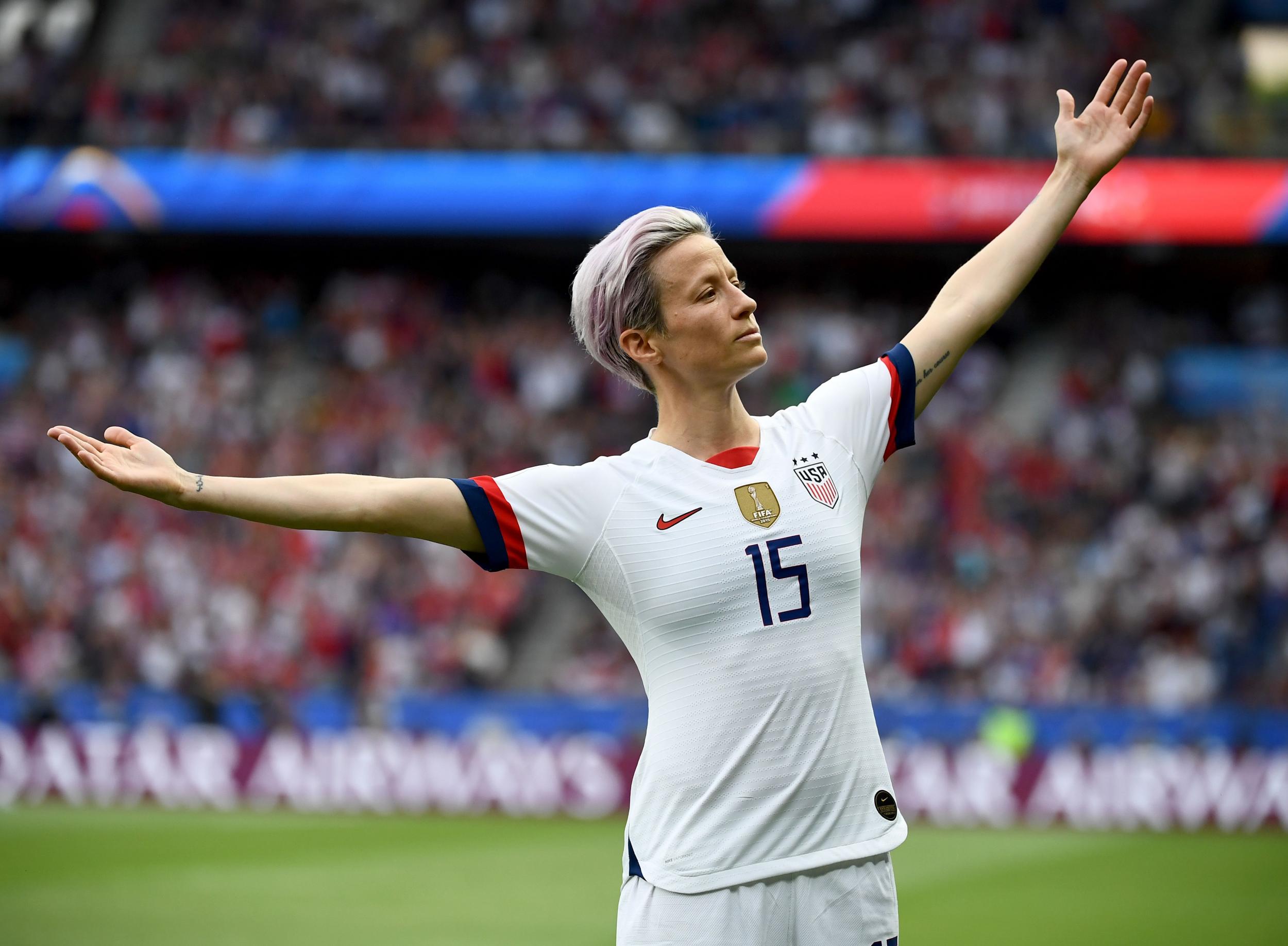This website uses cookies so that we can provide you with the best user experience possible. Cookie information is stored in your browser and performs functions such as recognising you when you return to our website and helping our team to understand which sections of the website you find most interesting and useful.

Members of the US women’s national team are seeking more than $66 million in damages as part of their gender discrimination lawsuit against the US Soccer Federation.
The damages were included in slew of papers filed in US District Court in Los Angeles on Thursday ahead of a trial scheduled to start May 5.
Among the documents filed were the separate collective bargaining agreements of the U.S. men’s and women’s teams, which had not previously been made public.
Players on the women’s national team sued the federation last March alleging institutionalized gender discrimination that includes inequitable compensation between the men’s and women’s teams.
Each side in the class-action lawsuit asked for a summary judgment in their favor. The estimate of damages, including interest, was provided by Finnie Bevin Cook, an economist from Deiter Consulting Group, which was retained by the suing players.
The collective bargaining agreements showed a disparity in bonuses but also highlighted the different pay structures between the two teams.
Created with Sketch.
Created with Sketch.
1/32 Womens World Cup best pictures
AFP/Getty Images
2/32 Womens World Cup best pictures
Getty Images
3/32 Womens World Cup best pictures
AFP/Getty Images
4/32 Womens World Cup best pictures
Getty Images
5/32 Womens World Cup best pictures
AFP/Getty Images
6/32 Womens World Cup best pictures
Getty Images
7/32 Womens World Cup best pictures
Getty Images
8/32 Womens World Cup best pictures
Getty Images
9/32 Womens World Cup best pictures
Getty Images
10/32 Womens World Cup best pictures
Getty Images
11/32 Womens World Cup best pictures
AFP/Getty Images
12/32 Womens World Cup best pictures
AFP/Getty Images
13/32 Womens World Cup best pictures
AFP/Getty Images
14/32 Womens World Cup best pictures
AFP/Getty Images
15/32 Womens World Cup best pictures
AFP/Getty Images
16/32 Womens World Cup best pictures
AFP/Getty Images
17/32 Womens World Cup best pictures
AFP/Getty Images
18/32 Womens World Cup best pictures
AFP/Getty Images
19/32 Womens World Cup best pictures
AFP/Getty Images
20/32 Womens World Cup best pictures
AFP/Getty Images
21/32 Womens World Cup best pictures
AFP/Getty Images
22/32 Womens World Cup best pictures
AFP/Getty Images
23/32 Womens World Cup best pictures
AFP/Getty Images
24/32 Womens World Cup best pictures
AFP/Getty Images
25/32 Womens World Cup best pictures
AFP/Getty Images
26/32 Womens World Cup best pictures
AFP/Getty Images
27/32 Womens World Cup best pictures
AFP/Getty Images
28/32 Womens World Cup best pictures
AFP/Getty Images
29/32 Womens World Cup best pictures
AFP/Getty Images
30/32 Womens World Cup best pictures
AFP/Getty Images
31/32 Womens World Cup best pictures
AFP/Getty Images
32/32 Womens World Cup best pictures
Australia celebrate beating Brazil in their Group C tie
Getty
1/32 Womens World Cup best pictures
AFP/Getty Images
2/32 Womens World Cup best pictures
Getty Images
3/32 Womens World Cup best pictures
AFP/Getty Images
4/32 Womens World Cup best pictures
Getty Images
5/32 Womens World Cup best pictures
AFP/Getty Images
6/32 Womens World Cup best pictures
Getty Images
7/32 Womens World Cup best pictures
Getty Images
8/32 Womens World Cup best pictures
Getty Images
9/32 Womens World Cup best pictures
Getty Images
10/32 Womens World Cup best pictures
Getty Images
11/32 Womens World Cup best pictures
AFP/Getty Images
12/32 Womens World Cup best pictures
AFP/Getty Images
13/32 Womens World Cup best pictures
AFP/Getty Images
14/32 Womens World Cup best pictures
AFP/Getty Images
15/32 Womens World Cup best pictures
AFP/Getty Images
16/32 Womens World Cup best pictures
AFP/Getty Images
17/32 Womens World Cup best pictures
AFP/Getty Images
18/32 Womens World Cup best pictures
AFP/Getty Images
19/32 Womens World Cup best pictures
AFP/Getty Images
20/32 Womens World Cup best pictures
AFP/Getty Images
21/32 Womens World Cup best pictures
AFP/Getty Images
22/32 Womens World Cup best pictures
AFP/Getty Images
23/32 Womens World Cup best pictures
AFP/Getty Images
24/32 Womens World Cup best pictures
AFP/Getty Images
25/32 Womens World Cup best pictures
AFP/Getty Images
26/32 Womens World Cup best pictures
AFP/Getty Images
27/32 Womens World Cup best pictures
AFP/Getty Images
28/32 Womens World Cup best pictures
AFP/Getty Images
29/32 Womens World Cup best pictures
AFP/Getty Images
30/32 Womens World Cup best pictures
AFP/Getty Images
31/32 Womens World Cup best pictures
AFP/Getty Images
32/32 Womens World Cup best pictures
Australia celebrate beating Brazil in their Group C tie
Getty
“Women’s national team players are paid differently because they specifically asked for and negotiated a completely different contract than the men’s national team, despite being offered, and rejecting, a similar pay-to-play agreement during the past negotiations,” U.S. Soccer said in a statement. “Their preference was a contract that provides significant additional benefits that the men’s national team does not have, including guaranteed annual salaries, medical and dental insurance, paid child-care assistance, paid pregnancy and parental leave, severance benefits, salary continuation during periods of injury, access to a retirement plan, multiple bonuses and more.”
Molly Levinson, spokeswoman for the plaintiffs, disputed the federation’s assertions.
“In the most recent CBA negotiation, USSF repeatedly said that equal pay was not an option regardless of pay structure,” Levinson said in a statement. “USSF proposed a ‘pay to play structure’ with less pay across the board. In every instance for a friendly or competitive match, the women players were offered less pay that their male counterparts. This is the very definition of gender discrimination, and of course the players rejected it.”
The lawsuit has drawn worldwide attention. When the United States won the World Cup final last summer in France, fans in the crowd chanted “Equal Pay! Equal Pay!”
Earlier this month, the players union for the men’s national team urged the federation to sharply increase pay for the women’s team, while also accusing the governing body of making low-ball offers in current contract negotiations with the men’s team.
AP



 Africana55 Radio
Africana55 Radio 

